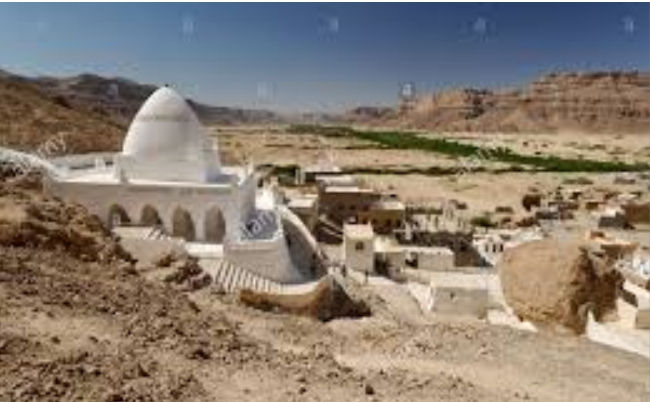الأنبياء العرب
Three pre-Islamic Arabian prophets, Hūd, Ṣāliḥ and Shu`ayb.
Stephen Lambden, UC Merced.
In Progress - last updated 30-12-2020.
Certain Islamic traditions reckon Hūd (=05), Ṣāliḥ (=06), Shu`ayb (=07), Ibrāhīm (=08) and Muhammad (= 028) the five "Arabian prophets".

One of the many shrines allegedly that of the prophet Hūd in Hadhramaut, Yemen.
See further : https://www.islamiclandmarks.com/various/maqam-of-prophet-hud-as
05. Hūd R. Possibly the biblical Heber (Heb. ḥeber)
Possibly (Ar.) `Ābar the Kenite, a descendant of Hobab and father-in-law of Moses (? Judg. 4:11). Q title sūra 11 and x 7 Hūd is seven times mentioned in 3 sūras of the Qur'an. Hūd is also the title of sūra 11. It has been supposed that Hūd is a purely allegorical ancestor of the Jews cf. EI2 Wensinck [Pellat] art.`Hūd’). . In the Q. Hūd is a messenger sent to his people `Ād whose story is related three times in three sūras (Q.7:63-70; 11:50-60; 26:123-40). His monotheistic message was ridiculed by the `Ādites (of al-aḥqāf, "the sand dunes"; Q.46:21). In consequence they were largely destroyed by the violent ṣarṣar ("clamorous [raging] wind").
Hūd finds succinct qiṣaṣ al-anbiyā’-rooted mention in select Bābī-Bahā’ī sources. In his Surat al-Nuṣḥ (c. 1861?) Baha'-Allah refers to Hūd as a nabī (prophet) sent to both orient and occident (S-Nuṣḥ, 246; cf. KI:7-8 /6-7).
06. Ṣāliḥ, a Rasul (Sent Messenger) and a Nabi (Prophet), is mentioned nine times in 6 sūras of the Qur'an. He was a (pre-Abrahamic?) prophet sent to the tribe of Thamūd (Q. 7:73-9, etc). He came with the "sign", "proof" or "test" of the nāqa (`[she-] camel’) but was rejected. His mocking audience were all destroyed by a storm or earthquake. BA* explained (the tribe of) "Thamud" allegorically as opponents of truth in any [46] age (BA* T-Shams, 15-16; cf. S-Nuṣḥ, 246; KI 7-8/7). He quite frequently utilized the motif of the "she-camel" (L-Dhi`b/ESW, index) On one occasion AB* explained that the nāqa indicates Ṣālīḥ’s "sanctified self" (nafs-i muqaddas). Being "hamstrung" indicated an event within Ṣālīḥ precipitated by his enemies which prevented him from proffering the "milk" of spiritual beatitude to his people (AB* Ma’idih 2:99).
07. Shu`ayb, R+N, perhaps the biblical [uncle of ?] Jethro (Heb. Yitrô,) priest of Midian and father of Zipporah the wife of Moses, the father-in-law of Moses (Exod. 3:1; 4:18; 18:1ff; Qx11 in 3 Sūrahs). A messenger-prophet sent with risālāt ("messages") to the people of Madyan (Midian, NW Arabia? cf. Q. 20:40; 28:22f) or the aṣḥāb al-ayka ("people of the thicket"; Q. 7:83-91, etc).1
A qur’ānic rasūl though not a Bābī-Bahā’ī maẓhar-i ilāhī, Shu`ayb is infrequently mentioned in Bābī- Bahā’ī sources (BA* KI:7-8 /7).
SELECT BIBLIOGRAPHY
Wheeler, Brannon , `Arab Prophets of the Qur'an and Bible / الأنبياء العرب في القرآن والکتاب المقدس' in Journal of Qur'anic Studies Vol. 8, No. 2 (2006), pp. 24-57. Edinburgh University Press. https://www.jstor.org/stable/25728216
